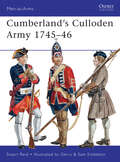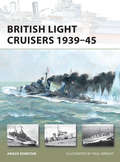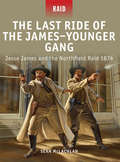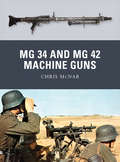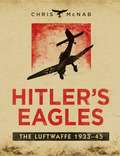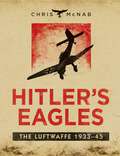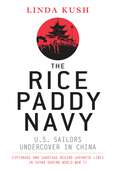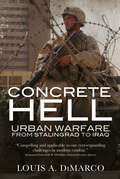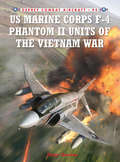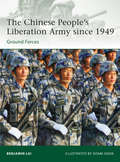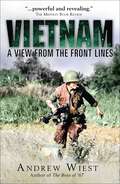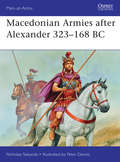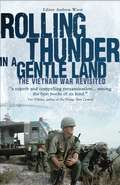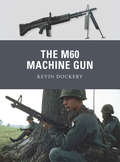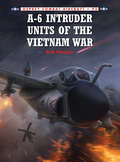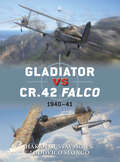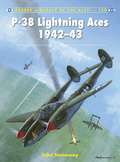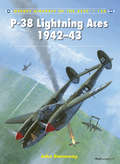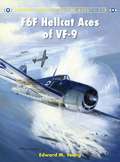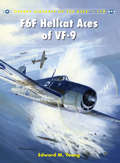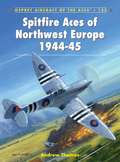- Table View
- List View
Cumberland’s Culloden Army 1745–46 (Men-at-Arms #483)
by Stuart ReidIn August 1745 Charles Edward Stuart, the 'Young Pretender', landed in Scotland and sparked the Second Jacobite Rising. The Jacobite forces seized Perth, then Edinburgh, where they proclaimed the Young Pretender's father King James VIII; they trounced their Hanoverian opponents at Prestonpans and crossed into England, getting as far south as Derby before withdrawing into Scotland. Far from universally popular north of the border, the Jacobite army bested another Hanoverian army at Falkirk and besieged Stirling, only to be routed by the Duke of Cumberland's army at Culloden in April 1746, a crushing defeat that ended any prospect of a Stuart restoration. Featuring full-colour artwork depicting the distinctive uniforms of Cumberland's men, this exhaustively researched study offers a wealth of detail of regimental strengths and casualties and includes an extended chronology that places individual units in specific places throughout the campaign that culminated at Culloden.
British Light Cruisers 1939–45 (New Vanguard #194)
by Paul Wright Angus KonstamThe light cruiser was a natural development of the sailing frigate – a fast multi-purpose warship that could patrol the sea lanes, protect convoys and scout for enemy battle fleets. By the inter-war period the need for this type of ship was even more important, given the increasing need for protection from aircraft, and the need to screen the fleet from submarines or destroyers. Wartime experience had shown that the British light cruiser was one of the most versatile types of ship in the Royal Navy, able to protect other warships, bombard enemy shores, guard life-saving convoys and intercept and destroy enemy warships. These were truly the workhorses of the wartime Royal Navy. While the battleships and carriers grabbed the headlines, these sleek, elegant warships quietly got on with the job of securing control of the seas.
The Last Ride of the James–Younger Gang: Jesse James and the Northfield Raid 1876 (Raid #35)
by Peter Dennis Johnny Shumate Sean McLachlanIt was the beginning of the end for the James gang. In the past ten years Frank and Jesse James had gone from unknown ex-Confederate guerrillas to the most famous outlaws in the world. A string of daring robberies of banks, trains, and stagecoaches had brought them fame, admiration, hatred, and a surprisingly small amount of wealth. In 1876 they planned their most daring raid yet-to ride hundreds of miles from their home state of Missouri to rob the First National Bank at Northfield, Minnesota. This book will tell the story of one of the most daring bank jobs in American history. With most of the gang being former bushwhackers, they used many guerrilla tactics in the planning and execution of the raid, yet failed because of poor discipline and their own fame, which meant that every town in the Midwest had their guns loaded waiting to fight off bandits.
MG 34 and MG 42 Machine Guns (Weapon)
by Ramiro Bujeiro Chris McNab Alan GillilandWith the MG 34, the German Wehrmacht introduced an entirely new concept in automatic firepower – the general-purpose machine gun (GPMG). In itself the MG 34 was an excellent weapon: an air-cooled, recoil-operated machine gun that could deliver killing firepower at ranges of more than 1,000m. Yet simply by changing its mount and feed mechanism, the operator could radically transform its function. On its standard bipod it was a light machine gun, ideal for infantry assaults; on a tripod it could serve as a sustained-fire medium machine gun. During World War II, the MG 34 was superseded by a new GPMG – the MG 42. More efficient to manufacture and more robust, it had a blistering 1,200rpm rate of fire. Nicknamed 'Hitler's buzzsaw' by Allied troops, it was arguably the finest all-round GPMG ever produced, and alongside the MG 34 it inflicted heavy casualties. Featuring specially commissioned full-colour artwork and drawing upon numerous technical manuals and first-hand accounts, this study explores the technological development, varied roles and lasting influence of the revolutionary MG 34 and MG 42 machine guns and their postwar successors.
Hitler’s Eagles: The Luftwaffe 1933–45
by Chris McNabAt the beginning of World War II, the Luftwaffe was the world's most advanced air force. With superior tactics, aircraft and training, it cut through opposition air forces. Despite this auspicious beginning, by 1945 the Luftwaffe was a dying force. The Allies were destroying German aircraft at unequal rates, and Luftwaffe aviators were dying in their thousands in an unbalanced battle to save Germany from destruction. Hitler's Eagles charts the turbulent history of the Luftwaffe from its earliest days to its downfall. Once Hitler was in power, the Luftwaffe came out of the shadows and expanded under a massive rearmament programme, then embarked upon the war that would define its existence. As well as providing a detailed history of the Luftwaffe's combat experience, the book expands on its human and material aspects. Aces and commanders are profiled and aircraft are described both technologically and tactically. The book conveys all the drama of the Luftwaffe's existence with Osprey's famous aviation artwork bringing the story incomparably to life.
Hitler’s Eagles: The Luftwaffe 1933–45
by Chris McNabAt the beginning of World War II, the Luftwaffe was the world's most advanced air force. With superior tactics, aircraft and training, it cut through opposition air forces. Despite this auspicious beginning, by 1945 the Luftwaffe was a dying force. The Allies were destroying German aircraft at unequal rates, and Luftwaffe aviators were dying in their thousands in an unbalanced battle to save Germany from destruction. Hitler's Eagles charts the turbulent history of the Luftwaffe from its earliest days to its downfall. Once Hitler was in power, the Luftwaffe came out of the shadows and expanded under a massive rearmament programme, then embarked upon the war that would define its existence. As well as providing a detailed history of the Luftwaffe's combat experience, the book expands on its human and material aspects. Aces and commanders are profiled and aircraft are described both technologically and tactically. The book conveys all the drama of the Luftwaffe's existence with Osprey's famous aviation artwork bringing the story incomparably to life.
The Rice Paddy Navy: U.S. Sailors Undercover in China (General Military Ser.)
by Linda KushAfter the attack on Pearl Harbor, the U.S. Navy knew it would need vital information from the Pacific. After a meeting and a handshake agreement with Chiang Kai-shek, the Sino-American Cooperative Organization was born. This top-secret network worked hand in hand with the Nationalist Chinese to fight the Japanese occupation of China while it intercepted Japanese code, laid mines, and trained Chinese peasants in guerrilla warfare. Its work supplied critical information to the U.S. and contributed to the felling of more than 70,000 Japanese – while losing only five of their own men. SACO – “the rice paddy navy” – was one of the best-kept secrets of the war. Linda Kush uncovers the military accomplishments and political wrangling that colored one of the most successful – and little known – efforts of World War II.
Concrete Hell: Urban Warfare From Stalingrad to Iraq (General Military Ser.)
by Louis A. DiMarcoThroughout history cities have been at the center of warfare, from sieges to street-fighting, from peace-keeping to coups de mains. Sun Tzu admonished his readers of The Art of War that the lowest realization of warfare was to attack a fortified city. Indeed, although strategists have advised against it across the millennia, armies and generals have been forced nonetheless to attack and defend cities, and victory has required that they do it well. In Concrete Hell Louis DiMarco has provided a masterful study of the brutal realities of urban warfare, of what it means to seize and hold a city literally block by block. Such a study could not be more timely. We live in an increasingly urbanizing world, a military unprepared for urban operations is unprepared for tomorrow. Di Marco masterfully studies the successes and failures of past battles in order to provide lessons for today's tacticians.
Concrete Hell: Urban Warfare From Stalingrad to Iraq
by Louis A. DiMarcoThroughout history cities have been at the center of warfare, from sieges to street-fighting, from peace-keeping to coups de mains. Sun Tzu admonished his readers of The Art of War that the lowest realization of warfare was to attack a fortified city. Indeed, although strategists have advised against it across the millennia, armies and generals have been forced nonetheless to attack and defend cities, and victory has required that they do it well. In Concrete Hell Louis DiMarco has provided a masterful study of the brutal realities of urban warfare, of what it means to seize and hold a city literally block by block. Such a study could not be more timely. We live in an increasingly urbanizing world, a military unprepared for urban operations is unprepared for tomorrow. Di Marco masterfully studies the successes and failures of past battles in order to provide lessons for today's tacticians.
America’s Elite: US Special Forces from the American Revolution to the Present Day (General Military Ser.)
by Chris McNabAmerica's Elites takes the reader through some of the most dramatic special forces operations in US history, from sniping British commanders during the Revolutionary War to Riverine incursions in the Mekong Delta in Vietnam, and from demolition missions on D-Day to the SEAL assault on Osama bin Laden's compound in 2011. Training and selection procedures are explained in detail, and the book also describes some of the technologies that have separated regular soldiers from their Special Forces counterparts. Illustrated throughout with striking photography and artworks, America's Elites forms the most comprehensive and visually impressive single-volume guide to US Special Forces available.
America’s Elite: US Special Forces from the American Revolution to the Present Day
by Chris McNabAmerica's Elites takes the reader through some of the most dramatic special forces operations in US history, from sniping British commanders during the Revolutionary War to Riverine incursions in the Mekong Delta in Vietnam, and from demolition missions on D-Day to the SEAL assault on Osama bin Laden's compound in 2011. Training and selection procedures are explained in detail, and the book also describes some of the technologies that have separated regular soldiers from their Special Forces counterparts. Illustrated throughout with striking photography and artworks, America's Elites forms the most comprehensive and visually impressive single-volume guide to US Special Forces available.
US Marine Corps F-4 Phantom II Units of the Vietnam War (Combat Aircraft #94)
by Jim Laurier Peter E. DaviesTwenty-five US Marine Corps squadrons flew versions of the Phantom II and 11 of them used the aircraft in South-East Asia from May 1965 through to early 1973. Rather than the air-to-air missiles that were the main component in the original F-4 armament, these aircraft carried an ever-expanding range of weaponry. Some toted 24,500-lb bombs and others strafed with up to three 20 mm gun pods, while most flew daily sorties delivering napalm, Snakeye bombs and big Zuni rockets. Many US Marines holding small outpost positions in Laos and South Vietnam against heavy Viet Cong attack owed their lives to the Phantom II pilots who repeatedly drove off the enemy. The book will examine these missions in the context of US Marine Corps close-support doctrine, using the direct experience of a selection of the aircrew who flew and organised those missions.
The Chinese People’s Liberation Army since 1949: Ground Forces (Elite #194)
by Adam Hook Benjamin LaiThe Chinese People's Liberation Army (PLA) is the largest army in the world. China is predicted to be on the brink of overtaking the USA as the world's largest economy, and China's military capabilities and global ambitions are the single greatest long-term pre-occupation of Western governments. The PLA has progressed steadily – if slowly – since its creation in 1949, from a mass army of unsophisticated infantry limited to 'human wave' tactics into a highly sophisticated force with wide capabilities. The most recent reforms (1989 to the present day) have been made possible by massive economic liberalization, and have seen not only the modernization of all the armed forces but the beginnings of global outreach, even including Chinese participation in UN peace-keeping missions to Africa, the Middle East, and Haiti. Featuring rare photographs and specially commissioned color artwork, this study explores the developing structure, organization, equipment, appearance, and character of the Chinese People's Liberation Army from its creation until today.
Vietnam: A View from the Front Lines
by Andrew WiestBased on rich collections housed at the National Archive, the Center of Military History, and at the Vietnam Archive at Texas Tech, Voices from America's Failed Crusade will trace the American experience of Vietnam from the war's popular inception to its morale-crushing and bitter conclusion. Being careful to demonstrate that the Vietnam War was actually several different wars both in time and in space, Voices from America's Failed Crusade will allow the reader a grunt's-eye view of the conflict – from the steaming rice paddies and swamps of the Mekong Delta, to the triple-canopy rainforest of the Central Highlands, to the forlorn Marine bases that dotted the DMZ. The stories contained within Voices from America's Failed Crusade will detail everything from heroism to fragging, from helicopters hitting the LZs to rampant drug use. It will be a true and grippingly accurate portrait of the American war in Vietnam through the eyes of the men and women who fought in that far away land.
Macedonian Armies after Alexander 323–168 BC (Men-at-Arms)
by Peter Dennis Nicholas SekundaThe death of Alexander the Great in 323 BC threw the Macedonians into confusion; there was no capable heir, and no clear successor among the senior figures in Alexander's circle. Initial attempts to preserve the unity of Alexander's conquests gave way to a period of bloody and prolonged warfare. For well over a century the largely mercenary armies of Alexander's successors imposed their influence over the whole of the Near East, while absorbing local military practices. After Rome's decisive defeat of Carthage in 202 BC, Macedonia came under increasing pressure from the Romans. Three wars between the two powers culminated in the Roman victory at Pydna in 168 BC, which laid Alexander's empire to rest and established Roman hegemony in the Near East. Drawing upon a wide array of archaeological and written sources and written by a noted authority on the Hellenistic period, this survey of the organization, battle history and appearance of the armies of Alexander's successors is lavishly illustrated with specially commissioned full-colour artwork.
Vietnam: A View from the Front Lines (General Military Ser.)
by Andrew WiestBased on rich collections housed at the National Archive, the Center of Military History, and at the Vietnam Archive at Texas Tech, Voices from America's Failed Crusade will trace the American experience of Vietnam from the war's popular inception to its morale-crushing and bitter conclusion. Being careful to demonstrate that the Vietnam War was actually several different wars both in time and in space, Voices from America's Failed Crusade will allow the reader a grunt's-eye view of the conflict – from the steaming rice paddies and swamps of the Mekong Delta, to the triple-canopy rainforest of the Central Highlands, to the forlorn Marine bases that dotted the DMZ. The stories contained within Voices from America's Failed Crusade will detail everything from heroism to fragging, from helicopters hitting the LZs to rampant drug use. It will be a true and grippingly accurate portrait of the American war in Vietnam through the eyes of the men and women who fought in that far away land.
Rolling Thunder in a Gentle Land: The Vietnam War Revisited
by Andrew WiestFifteen renowned authors from widely varied backgrounds examine the Vietnam War, providing a fresh insight into this controversial conflict, even for those who have 'read it all before'. First-hand accounts, maps and contemporary photographs, analysis from the soldiers involved and new perspectives from combatants on both sides provide an incisive investigation into a fascinating and terrible war."This is a superb and compelling reexamination of the major historical, political, and ethical issues that continue to smoulder many decades after the conclusion of the Vietnam War, I highly recommend Rolling Thunder in a Gentle Land. It is among the best books of its kind that I've encountered over the last dozen years.†? Tom O'Brien, author of The Things They Carried
The M60 Machine Gun (Weapon #20)
by Kevin Dockery Mark Stacey Alan GillilandThe US M60 General Purpose Machine Gun, known as "the Pig,†? was developed in the years after World War II from two revolutionary German designs. Adopted in 1957, the M60 came into its own in the jungles, hamlets, and city streets of Southeast Asia during the Vietnam War. "Humping the Pig†? became common in US military squads, with at least one soldier equipped with an M60 and every squad member carrying ammunition for it. The M60 design transformed infantry tactics as squads took advantage of the immediate volume of fire offered by the design. Although it has now been replaced by the M240 series of weapons in US infantry and mechanized units, the M60 is still in common use with the US armed forces. Meanwhile, its iconic status has been assured by its frequent appearance in many popular films and television shows, from Full Metal Jacket to The A Team. Featuring specially commissioned full-color artwork, this is the full story of the M60, the innovative squad base-of-fire weapon that has equipped the US military from the jungles of Vietnam to the deserts of Iraq.
A-6 Intruder Units of the Vietnam War (Combat Aircraft)
by Jim Laurier Rick MorganDesigned in the years following the Korean War and then manufactured for over 30 years starting in 1960, the A-6 quickly became the most capable attack aircraft in the US Navy's stable. The first squadron, VA-75, made its initial deployment directly into combat in south-east Asia in 1965, and, over the next eight years, ten US Navy and four Marine Intruder squadrons would conduct combat operations throughout Vietnam, Laos and Cambodia. After initial problems and a high loss rate, the type proved itself beyond all doubt as the Naval services' best night and foul-weather platform, particularly during the region's notorious monsoon season. The A-6 Intruder became a true classic of naval aviation over the skies of North Vietnam but the cost was high as 69 Intruders were lost in combat to all causes during the war. This work tells the complete story of these aircraft in combat during the Vietnam War.
Gladiator vs CR.42 Falco: 1940–41 (Duel #47)
by Ludovico Slongo Håkan GustavssonBoth the Gloster Gladiator and the Fiat CR.42 Falco represented the peak in the development of the biplane fighter, which could trace its lineage back to World War I. However, by the time both aircraft entered service in the late 1930s, they were already obsolete. Nevertheless, they gave sterling service on all fronts in the Mediterranean and Africa in 1940–41. Indeed, the CR.42 was the Regia Aeronautica's staple fighter in both North and East Africa, Greece and over Malta in 1940–41, during which time its pilots routinely fought British and Commonwealth squadrons equipped in the main with Gladiator biplanes. Some bitter dogfights were fought between these two types as the Allies attempted to gain control of the skies over North Africa, Greece and East Africa. Both types were flown in the main by highly experienced pre-war pilots, and this in turn made for some closely fought engagements. The first known combat between the CR.42 and the Gladiator took place on 14 June 1940 over North Africa and the last engagement between the two types occurred on 24 October 1941 over the East African front.
P-38 Lightning Aces 1942–43 (Aircraft of the Aces)
by Chris Davey John StanawayThe first P-38s became operational with the 1st Fighter Group in April 1941, and the initial combat deployments were made in Alaska, the Southwest Pacific and North Africa during the latter part of 1942. Photographic reconnaissance versions of the P-38 were in action even sooner when F-4 (P-38E) models were rushed to frontline units a few months after Pearl Harbor. Often using modified field measures to equip aircraft and train pilots in this demanding fighter, early pilots wrote a remarkable record of accomplishments that displayed a high degree of courage and innovation. Every theatre in which the United States was involved saw deployment of the P-38, and more than 60 Lightning pilots were credited with at least five victories by the end of 1943. Featuring illustrations depicting P-38 models from the E to the H-5 previously not known to the general public, unpublished photographs and new data, this volume presents a comprehensive and innovative account of some of these lesser known aces.
P-38 Lightning Aces 1942–43 (Aircraft of the Aces #120)
by Chris Davey John StanawayThe first P-38s became operational with the 1st Fighter Group in April 1941, and the initial combat deployments were made in Alaska, the Southwest Pacific and North Africa during the latter part of 1942. Photographic reconnaissance versions of the P-38 were in action even sooner when F-4 (P-38E) models were rushed to frontline units a few months after Pearl Harbor. Often using modified field measures to equip aircraft and train pilots in this demanding fighter, early pilots wrote a remarkable record of accomplishments that displayed a high degree of courage and innovation. Every theatre in which the United States was involved saw deployment of the P-38, and more than 60 Lightning pilots were credited with at least five victories by the end of 1943. Featuring illustrations depicting P-38 models from the E to the H-5 previously not known to the general public, unpublished photographs and new data, this volume presents a comprehensive and innovative account of some of these lesser known aces.
F6F Hellcat Aces of VF-9 (Aircraft of the Aces)
by Jim Laurier Edward M. YoungVF-9 was activated in March 1942 as part of Carrier Air Group (CAG) 9, one of the many air groups the US Navy was hurriedly forming in the aftermath of the Japanese attack on Pearl Harbor. Equipped with Grumman F4F Wildcats, VF-9 first saw combat during the Allied invasion of North Africa in November 1942, where the squadron engaged Vichy French fighters over Morocco. Returning to the United States, VF-9 became one of the first squadrons to receive the Grumman F6F Hellcat and to deploy on the USS Essex, the first of its class of fleet carriers that would form the backbone of the US Navy's Fast Carrier Task Force. VF-9, the Hellcat, and the Essex all entered combat in the fall of 1943. In the hands of the squadron's pilots, and with other Navy fighter squadrons, the Hellcat proved superior to the Imperial Japanese Navy's A6M Zero, which had heretofore been the world's premier carrier fighter plane.
F6F Hellcat Aces of VF-9 (Aircraft of the Aces #119)
by Jim Laurier Edward M. YoungVF-9 was activated in March 1942 as part of Carrier Air Group (CAG) 9, one of the many air groups the US Navy was hurriedly forming in the aftermath of the Japanese attack on Pearl Harbor. Equipped with Grumman F4F Wildcats, VF-9 first saw combat during the Allied invasion of North Africa in November 1942, where the squadron engaged Vichy French fighters over Morocco. Returning to the United States, VF-9 became one of the first squadrons to receive the Grumman F6F Hellcat and to deploy on the USS Essex, the first of its class of fleet carriers that would form the backbone of the US Navy's Fast Carrier Task Force. VF-9, the Hellcat, and the Essex all entered combat in the fall of 1943. In the hands of the squadron's pilots, and with other Navy fighter squadrons, the Hellcat proved superior to the Imperial Japanese Navy's A6M Zero, which had heretofore been the world's premier carrier fighter plane.
Spitfire Aces of Northwest Europe 1944-45 (Aircraft of the Aces)
by Andrew Thomas Chris ThomasThis book traces the achievements of the pilots flying the iconic Spitfire in Northwest Europe, and examines how the steady technological improvements that were made throughout the Spitfire's service life improved its capabilities in the air. Based at airfields throughout southern England, Merlin engine Spitfires provided the bulk of the air cover for the D-Day landings and it was an RCAF Spitfire which claimed the first ever ME 262 jet kill. 36 colour profiles covering a broad spectrum of nationalities, units, pilots, theatres and markings complement thorough research throughout this comprehensive account of these crucial fighter aircraft.
